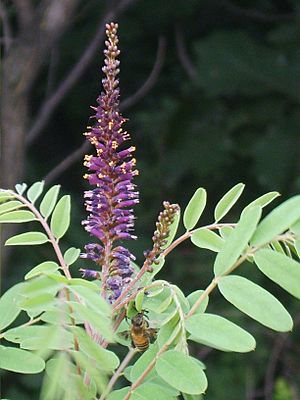Amorpha fruticosa facts for kids
Quick facts for kids Amorpha fruticosa |
|
|---|---|
 |
|
| Scientific classification | |
| Kingdom: | |
| (unranked): | |
| (unranked): | |
| (unranked): | |
| Order: | |
| Family: | |
| Subfamily: | |
| Genus: |
Amorpha
|
| Species: |
A. fruticosa
|
| Binomial name | |
| Amorpha fruticosa |
|
| Synonyms | |
|
|
Amorpha fruticosa is a type of flowering plant in the Fabaceae family, also known as the pea or legume family. People often call it by names like desert false indigo or false indigo-bush. This plant naturally grows in North America.
Contents
About the False Indigo-Bush
This plant is a shrub that can grow quite tall, up to 5 or 6 meters (about 16 to 20 feet). It can also spread out wide, sometimes twice its height. It doesn't have thorns, and its leaves are made of many small, oval-shaped parts called leaflets. These leaflets are a bit hairy and have a tiny spine at their tip.
The plant's flowers grow in a spike-like cluster called a raceme. Each flower has a single purple petal. Ten yellow stamens stick out from the flower. After the flowers, small pods form. These are called legume pods, and each one usually holds one or two seeds.
Where It Grows
The false indigo-bush is native to most of the United States, southeastern Canada, and northern Mexico. This means it grew there naturally for a long time. However, it has also spread to other parts of its current range, like the northeastern and northwestern U.S.
You can also find this plant in Europe, Asia, and other places. In these areas, it is an introduced species. This means people brought it there. It's often grown in gardens because it looks nice. Some wild plants you see might have grown from seeds that escaped from gardens.
Special Chemicals
The fruits of Amorpha fruticosa contain special chemicals. Some of these chemicals are called amorfrutins. Scientists have found that these chemicals might help fight against certain health problems. For example, they could be useful in dealing with diabetes and other related health issues.
Plant Life and Animals
The false indigo-bush is an important plant for several insects. It acts as a "larval host" for them. This means that the young insects, called larvae (like caterpillars), live on this plant and eat its leaves.
Some of the butterflies and moths that use Amorpha fruticosa as a host plant include:
- Clouded sulphur butterfly
- Gray hairstreak butterfly
- Hoary edge butterfly
- Io moth
- Marine blue butterfly
- Silver-spotted skipper
- Southern dogface butterfly
Different Types of False Indigo-Bush
People have grown different types of Amorpha fruticosa for gardens. These are called "cultivars." Here are a few examples:
- 'Albiflora': This type has white flowers instead of purple ones.
- 'Crispa': This one has leaves that are curled.
- 'Lewisii': This type has narrow, thin leaves.
- 'Pendula': This cultivar has branches that arch downwards, making the plant look like a dome.
Images for kids
See also
 In Spanish: Añil bastardo de Cayena para niños
In Spanish: Añil bastardo de Cayena para niños


